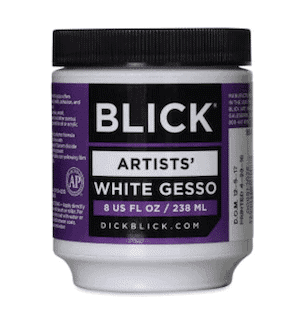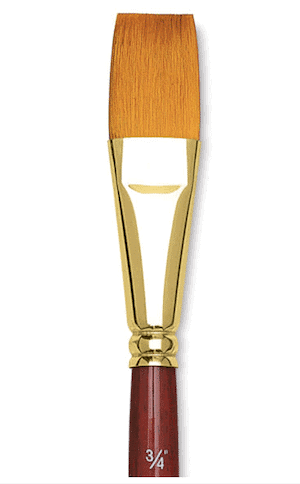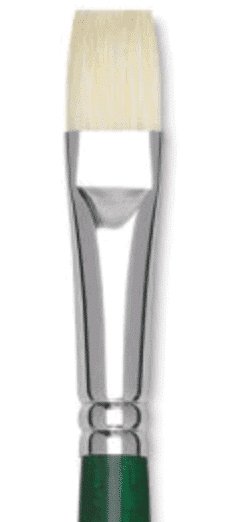How To Make Acrylic Paint Smooth
This post may contain affiliate links
It's so frustrating to have a beautiful and buttery acrylic painting envisioned in your mind, only for it to be full of steaks and obvious brush strokes. You try adding water; redoing your brush strokes; switching brushes; nothing seems to work. How can you eliminate brush strokes and streaks for good and have smooth acrylic paint from now on?
For smooth acrylic paint strokes without streaks, it's important to properly gesso your canvas before starting, use an additive with your acrylic paint, choose the right brush that has soft and long bristles, and work quickly without letting any paint streaks dry.
It takes some practice to achieve smooth acrylic paint strokes, but once you get the hang of it, acrylic painting without streaks will be a natural part of your acrylic painting life. Here are some tips to get you started.
1. Apply Gesso to Your Canvas
Gesso is a paint mixture that's used to prime canvases prior to painting (source).
Store bought canvases come with a layer of gesso already on them, but it's usually not enough. Also, you can't be sure how your canvases were manufactured and whether additional additives were left on the surface.
This can lead to problems with your paints sticking or spreading across your canvas. This can make it hard to use consistent strokes, let alone avoid streaks. Not good. Watch the video to see the difference between a canvas with gesso and one without. It also has a great tutorial about how to apply your gesso.

Click here to check out Dick Blick's great gesso!
To make sure that you get the best and most consistent results every single time, it's a good idea to get into the practice of gessoing your canvas.
Even if you're buying high quality canvases that usually work well out of the packaging, applying your own gesso gives you an extra level of control. You just never know when there will be a fluke in design or change in manufacturing that could impact the surface of your canvas.

Gessoing also gives you an extra smooth surface that will help you fight off acrylic paint streaks from the get go.
Check out this video on how to apply gesso.
2. Use an Additive with Your Acrylic Paint, like Flow Improver
If you feel like your acrylic paint just isn't spreading like you want it to, there's a way to increase the impact of your paint without decreasing its quality.
Enter, flow improver.
Flow improver does just what its name implies: improve the flow of your acrylic paint. This is especially useful when you want to complete washes or cover large areas of canvas without worrying about inconsistencies and streaks.
So, why can't you just use water?
When you mix water into your acrylic paints, it breaks down the acrylic binders, which isn't ideal. This could dilute the colors of your paints and make them resemble watercolors more than acrylics (source).

Click here to check out this great flow improver on Dick Blick!
This can lead to a vicious cycle that will only make your paint streaks worse. Trying to counteract the thin and dilute colors of your paints, you might try to compensate by adding more and more layers, which will just open up more opportunities for streaks.
A flow improver actually thins your paints without compromising the colors or quality. This means that you can increase the value and spread of your paint without the consequences of diluted colors, water droplets, or inconsistent paint strokes.
3. Choose the Right Brush
Having high quality brushes and taking good care of them is always important. When it comes to streaky acrylic paints, you'll see why.
If you have stiff and crunchy brushes with squashed bristles that stick out all over the place, you'll need an artistic miracle to avoid streaks and achieve smooth acrylic paint brush strokes. It's really hard to get poor quality brushes that have been mishandled to produce the high quality results you're looking for.
For the purposes of smooth acrylic paint strokes, you will want to choose paint brushes that have soft and long bristles.
The soft and long bristles will help you stay light-handed with your work and will, by default, apply less pressure on your canvas than their shorter and stiffer counterparts.
If you're on a really tight budget, get whatever soft and long bristled brushes you can afford. But, if you can swing it, go for some high quality brushes that you can gush over. When you get a high quality paint brush, it will maintain its shape for longer and feel easier to control.
Not to mention that high quality products tend to last longer and will serve you for more years of your art career than a cheaper variety.
Grumbacher Goldenedge paint brushes are a great high quality choice to test out. These paint brushes are made with high quality synthetic fibers that will last a long time, painting after painting. Even though they can be pricey, these Grumbacher Goldenedge paint brushes will take your acrylic painting to the next level. Brushes in the Goldenedge series come in both round and flat varieties, giving you options for detail and large scale work.
If you would prefer a natural choice, Grumbacher also has a great set of brushes in their Gainsborough series. Similar to the other products they sell, their Gainsborough brushes are high quality and designed to last. These brushes are made of natural bristles, Chungking hog bristle to be exact and come in both round and flat varieties.

Click here to check out Goldenedge brushes on Dick Blick!

Click here to check out Gainsborough brushes on Dick Blick!
4. Don't Let It Dry
We all love the idea of a slow and leisurely afternoon spent painting. Sure, let the afternoon be slow and leisurely, but be sure to keep the paint moving.
Don't let your acrylic streaks dry on your canvas. If you do, they will be challenging to pick back up and smooth out. Even if you concede to redoing a section, your dried streaks can mess with the overall consistency of your painting's surface and make it hard for you to obtain a smooth appearance.
Once you've laid down some paint strokes, don't let it sit and dry out until you are happy with it.
Unlike oil paints that seem to take decades to dry, acrylic paints dry fairly quickly. This is nice when you want to build layers, but annoying when you're working with a big canvas or need extra time for detail work.
If you're worried that your acrylic paint will dry too quickly, I highly suggest using a paint retarder. A paint retarder extends the "open" time of your paint. Basically, this just means that it extends the amount of time it takes your acrylic paint to dry.
Similar to flow improver, you'll want to use paint retarder sparingly. Make sure to follow the directions on the bottle so that you don't end up with strange paint that won't dry for the next 100 years.

Click here to check out paint retarder on Dick Blick!
Watch the video for a great tutorial on applying and using paint retarder. The video also notes the importance of using paint retarder when you're working outdoors or in other hot environments. This is key to keep in mind. If you don't accommodate for the higher temps by using paint retarder, you'll end up with dry and crusty paints much more quickly than you're used to.
5. Use Sandpaper as Needed
Using sandpaper is a bit of a last resort, hail Mary, oops I let my painting sit for way too long type of strategy. If you've used the tips we've already talked about above, you likely won't ever find yourself needing to drag out the sandpaper. But, art is messy and things happen. It's good to have this sandpaper strategy in your back pocket in case you need it.
It might sound scary to take sandpaper to your precious painting, but it can actually be a great tool for decreasing the bumps and lines that come from heavy streaks of acrylic paint.
You might have heard about sanding walls or furniture while painting (source), but the same applies with paintings too. You'll just want to be more careful and gentle.
Make sure you have an extra fine sandpaper that isn't too harsh. If you come upon a stubborn streak that has created a ghastly bump or line, simply apply a light amount of pressure and sand it down a bit.
While you're sanding your paper, be sure that your paint is completely dry. You don't want to start sanding, only to find that the paint is still wet and you've now smudged it across your painting.
You also want to make sure that you're supporting the back of your canvas and not pushing so hard that you're causing strain to it.
Remember to have a gentle touch.
Achieving smooth acrylic paint brush strokes WILL take practice. If you're still learning how to paint, be patient with yourself and know that these skills will come with time. Hopefully the tips and tricks we've shared will set you off on the right path in your journey towards streak-free, smooth acrylic painting. Go forth and create great art!
How To Make Acrylic Paint Smooth
Source: https://adventureswithart.com/smooth-acrylic-paint-streaks/
Posted by: bermangreirrom.blogspot.com

0 Response to "How To Make Acrylic Paint Smooth"
Post a Comment